Mark Sisson's Blog, page 226
April 11, 2016
Dear Mark: Vegetarianism Causes Cancer?; Glucosamine Useless?; Decision Fatigue Debunked?
 For today’s edition of Dear Mark, I’m answer three questions. First, does long-term vegetarianism cause cancer or alter our genetic code? Some media coverage of the latest vegetarianism study seemed to suggest as much. Next, is glucosamine just totally useless if you’re not going to fork out a ton of money for pharmaceutical grade stuff? Maybe not, but let’s find out. And finally, I’ve written about decision fatigue a couple times before. What’s my take on the new research seeming to debunk one of the central concepts supporting it—ego depletion/finite willpower?
For today’s edition of Dear Mark, I’m answer three questions. First, does long-term vegetarianism cause cancer or alter our genetic code? Some media coverage of the latest vegetarianism study seemed to suggest as much. Next, is glucosamine just totally useless if you’re not going to fork out a ton of money for pharmaceutical grade stuff? Maybe not, but let’s find out. And finally, I’ve written about decision fatigue a couple times before. What’s my take on the new research seeming to debunk one of the central concepts supporting it—ego depletion/finite willpower?
Let’s go:
Hi Mark,
Did you hear the news about vegetarian diets changing the DNA of people who are on them for a long time and even causing cancer? Lines up pretty well with what you’ve been saying all these years.
Fletch
Okay, I should probably explain this study a little more. It’s really interesting but some folks are getting it wrong. They’re getting it wrong because the headlines are misleading and, sometimes, blatantly false.
No, long-term vegetarianism doesn’t alter your DNA. Long-term vegetarianism has altered the DNA of a population. Here’s how it works.
Long term vegetarianism in traditionally-vegetarian populations like South Asians has selected for certain traits. Because they eat very little animal foods, they get very little to no pre-formed long-chain PUFAs, which are found almost exclusively in animals. They have to rely on their own endogenous synthesis of these fats. In a long-term vegetarian population, traits which increase the ability to synthesize long-chain PUFAs from shorter ones will be selected for and provide benefits to reproduction and overall fitness. They are essential fatty acids, after all, especially important for building baby brains and ensuring proper development. If you can’t eat DHA, you’d better make it.
Traditionally vegetarian populations may very well benefit from their traditional vegetarian diet. My hunch is that a lack of availability of animal foods and other sources of pre-formed long-chain PUFAs (fatty fish, etc) selected for vegetarianism and made it fitness-enhancing. The people without the “vegetarian gene” wouldn’t fare as well in a vegetarian world; those with it would. It probably still enhances health given the proper context—an ancestral vegetarian diet. What does the fatty acid composition of an ancestral vegetarian diet look like for South Asians?
Well, ghee, mustard oil, and to a lesser extent coconut oil were the most common cooking fats before industrialization.
Ghee is mostly saturated fat, with the balance coming from monounsaturated fat (MUFA) and a small amount of CLA and omega-3s in the form of ALA (if grass-fed, which it likely was).
Mustard oil is about 60% MUFA, 20% PUFA (from linoleic acid), 12% SFA.
Coconut oil is almost entirely saturated fat.
So while they didn’t exactly eat high-fat diets, the fat they did eat was more SFA and MUFA than PUFA. And since they weren’t eating many animals, they needed an enhanced capacity to manufacture their own long-chain PUFAs from the modest amount of short-chain ones (linoleic and alpha-linolenic acids) they did eat. It worked well. Fewer precursors to long-chain PUFAs, more efficient conversion.
Things change, though, and what works well in one environment isn’t guaranteed to work well in another.
In modern India, a lot of the ghee and mustard oil have been replaced by vegetable ghee (basically trans-fat) and various cheaper vegetable and seed oils. What once was SFA/MUFA-rich and PUFA-moderate is now PUFA-rich with a side of industrial trans-fat. That’s a lot of precursors. And conversion from the precursors into long-chain PUFAs is poorly regulated by the body. If linoleic acid is lying around, the body is gonna try to convert it all into arachidonic acid. Someone with the “vegetarian gene” that makes them really, really good at converting linoleic acid into arachidonic is in trouble on a modern vegetarian diet. Excessive amounts of arachidonic acid (from unchecked conversion) crowd out the ALA-EPA/DHA conversion pathway, increase systemic inflammation, and are linked to heart disease and cancer. Bad stuff all around.
This is exactly why it’s important to heed your recent ancestry.
So I am wasting my money on my Glucosamine supplement (well, maybe the Chondroitin and MSM have been doing something lol) and I need a prescription manufactured by an Italian company. I sent them an email to see if it is available in the states. The type I’ve been using is the Hydrochloride shellfish free form. I did read this which seems to contradict the study that asserts only the pCGS form has therapeutic properties:
“Studies have shown glucosamine HCL, when combined with chondroitin sulphate, could help alleviate pain caused by degenerative joint disease. The results of a 16-week trial on 34 males who suffered chronic pain of the knee showed significant improvement in the relief of symptoms caused by osteoarthritis. The inclusion of sulphur in chondroitin sulphate is also thought to improve the effectiveness of cartilage development.”
Who knows for sure? Always learn something and / or get another perspective from Mark’s Sunday links.
No, I don’t think you’re necessarily wasting your money. I’ve gone back and forth on glucosamine. The “science-based medicine” crowd claims it’s totally useless, but I’m not so sure. A team of researchers in one study branded glucosamine sulfate powder with an identifying brand so that they could track where it went in the body after ingestion. When the subjects swallowed it, the glucosamine appeared in their synovial fluid. Synovial fluid sits inside the joint, providing lubrication and cartilage precursors like glucosamine to build and repair damaged cartilage, so this could be meaningful. A later study found that glucosamine sulfate was more effective than glucosamine hydrochloride at showing up in synovial fluid after oral dosing. You may want to try glucosamine sulfate, which when combined with chondroitin may improve moderate-to-severe knee pain and even reduce the rate of cartilage degradation.
While I agree with the concerns about such things as multi-tasking — our brains simply aren’t wired to cope with numerous tasks at once — I wouldn’t get too hung up on worrying about decision fatigue. Much of that notion arises out of research on “ego-depletion,” which may soon become infamous as one of the most oversold ideas in the history of psychology. A recent intensive effort to replicate one of the most basic findings has failed miserably, calling the whole field of research into question.
Wow, yeah. That’s pretty big. Here’s an article about the paper in question.
The funny thing is that ego depletion/decision fatigue exists for people who believe in it. That’s exactly what the research shows. So if you’ve benefited from thinking about your willpower as a finite resource, don’t read the article! Keep doing what you’re doing cause it’s working for you.
I still think the “decision fatigue” concept and post I wrote have merit, if only because too many decisions reduce quality of life. Making choices is just another thing to worry about. It takes time. It takes mental “energy,” even if we can’t quantify that energy or measure its depletion. And worst of all is when we don’t make the decision. When we sit there at the crossroads, agonizing over which single origin bean to select for our morning pour-over. Because until we make the decision, we can’t progress to the next one and get on with our day. Once or twice? No problem. But if every moment of your day features a decision to make and you can’t make it, you’re wasting your most valuable resource: time.
That’s it for today, everyone. What’s your take on the three subjects?
Thanks for reading!




April 10, 2016
Weekend Link Love – Edition 395
 Nell Stephenson of Paleoista fame is hosting a 2-day workshop retreat for women in Pacific Palisades, CA. Check it out if you’re interested!
Nell Stephenson of Paleoista fame is hosting a 2-day workshop retreat for women in Pacific Palisades, CA. Check it out if you’re interested!
Research of the Week
While it may not be the healthiest thing to drink, orange juice is certainly better for you than orange drink.
Moderation is relative, which is why it doesn’t really work.
Sunscreen: male birth control?
The colder you keep your house in the winter, the lower your waist size.
Researchers halted a trial for a new drug that failed to reduce heart attacks despite it reducing LDL by 37% and boosting HDL by 130% (!).
If you’ve got hereditary hemochromatosis (iron overload), blood donation improves the integrity of your genes.
The more natural light you get during the day, the less nighttime light impacts your melatonin secretion.
New Primal Blueprint Podcasts

Episode 114: Brad Kearns and Elle Russ on Burnout and Fatigue: Hosts Brad Kearns and Elle Russ chat about all things burnout and fatigue—how to spot it before it hits, how to deal with it, supplements to take, lifestyle measures to enact, exercise modifications to make, and much more.
Each week, select Mark’s Daily Apple blog posts are prepared as Primal Blueprint Podcasts. Need to catch up on reading, but don’t have the time? Prefer to listen to articles while on the go? Check out the new blog post podcasts below, and subscribe to the Primal Blueprint Podcast here so you never miss an episode.
15 Reasons Not to Trust That Latest Nutritional Study
How to Get Organized and Stay Focused in a Modern World
How to Develop Emotional Resilience in the Modern World
Interesting Blog Posts
Here’s why you don’t stop training—ever.
This is your brain on no sleep.
Why is American sheep cheese so expensive?
Media, Schmedia
Soda consumption hits a 30-year low.
Worldwide, the obese now outnumber the underweight.
Everything Else
Children get less outside time than prisoners.
Mom arrested for trusting children.
A new (to me) Gary Taubes talk.
Recipe Corner
Keep this tandoori masala spice mix around.
If you have an Instant Pot, or even just a steamer, make these Moroccan spiced potatoes.
Time Capsule
One year ago (Apr 13–Apr 19)
How Much Sugar is Recommended Per Day? – What are the various recommendations from around the world?
Dear Mark: Diet for Alzheimer’s; and the Role of Competitiveness in Modern Life – What works in Alzheimer’s, and how important is being competitive?
Picture of the Week

– Nature’s all-weather tire.
Like This Blog Post? Subscribe to the Mark's Daily Apple Newsletter and Get 10 eBooks and More Delivered to Your Inbox for FREE



April 9, 2016
Warm Coconut and Pancetta Kale

When you want something green on your plate but don’t feel like salad, then this warm coconut and pancetta kale is a go-to side dish. It pairs well with any type of meat or seafood. It’s easy to make. And although kale can taste good raw with just a drizzle of lemon and olive oil, it tastes really good with crispy pancetta, creamy coconut milk, and lots of garlic.
In fact, if you want to make these greens the main course and serve a small portion of protein on the side, go for it. Prepared this way, kale is filling and satisfying. Meat and seafood always have a place on the Primal table, but optimally, so does mineral-and-antioxidant-rich plant matter.
Eating leafy greens is like taking a whole food “supplement” with naturally safe and well-balanced vitamin and mineral levels. In this particular case, it’s an incredibly delicious supplement.
Is your vegetable crisper is full of greens that you have good intentions to eat before they go bad? Then use them in this recipe. In addition to kale, this recipe also works well with greens like collards and Swiss chard (or, a combination of greens).
Servings: 4
Time in the Kitchen: 30 minutes
Ingredients:

1 tablespoon coconut oil or butter (15 ml)
3 to 5 ounces pancetta, diced (85 to 140 g)
3 garlic cloves, finely chopped
1 shallot, thinly sliced
2 small bunches lacinato kale, leaves torn from stems and cut into thin strips
1/3 cup full-fat canned coconut milk (80 ml)
1/2 teaspoon red pepper flakes (2.5 ml)
Instructions:
Heat oil or butter in a wide skillet over medium heat. Add pancetta and cook until just crispy. Add garlic and shallot. Cook until shallot is soft, 5 minutes. If the garlic looks like it’s getting too dark, turn down the heat.
Add kale a couple handfuls at a time, letting the leaves wilt a little before adding more. Mix well with the pancetta, garlic and shallots. When all the kale is in the skillet, sauté as long as desired, either leaving the kale slightly raw or cooking it longer until the leaves are very soft.

Add coconut milk and red pepper flakes. Stir well and cook a minute or two more, until the coconut milk is absorbed by the kale.
Remove from heat and serve. This dish also tastes good at room temperature.
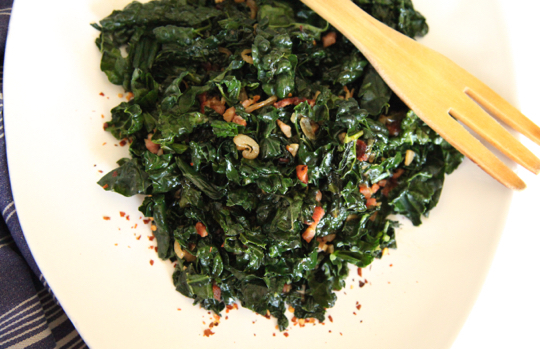




April 8, 2016
The Primal Transplant: A Story of Living with New Lungs, a New Lifestyle, and Swinging Kettlebells
It’s Friday, everyone! And that means another Primal Blueprint Real Life Story from a Mark’s Daily Apple reader. If you have your own success story and would like to share it with me and the Mark’s Daily Apple community please contact me here. I’ll continue to publish these each Friday as long as they keep coming in. Thank you for reading!
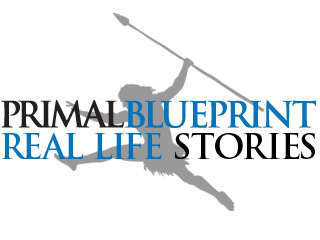 Hello, my name is John and I have been following The Primal Blueprint since May 5th, 2014. When I started I weighed 251 lbs with a BMI of 33.2. I was officially obese.
Hello, my name is John and I have been following The Primal Blueprint since May 5th, 2014. When I started I weighed 251 lbs with a BMI of 33.2. I was officially obese.
I also had a disease called Idiopathic Pulmonary Fibrosis (IPF). My lungs were reacting to some past damage and had gone into overdrive creating scar tissue. Basically, they were turning into raisins. Outside of a lung transplant, there is no real treatment for this disease. There are a couple drugs that have recently been approved by the FDA that do help some people slow the progress of the disease, and more in the clinical trial pipeline that look even more promising.
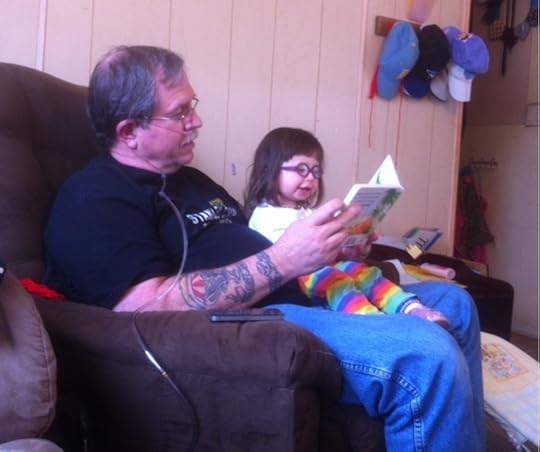
I needed to lose weight. I needed to lose weight so my body didn’t waste oxygen feeding fat. I also needed to lose weight so I could be considered for a lung transplant. There are not many lungs available for transplant, and ability to survive the procedure is one of the things that transplant teams look at when accessing potential candidates.
My lung capacity was less than 50% of normal. My lung’s ability to transfer oxygen to my blood was also less than 50% of normal. So basically with each breath I took, I was only getting somewhere around 25% of the oxygen of normal lungs.
 So I started with The Primal Blueprint 21-Day Total Body Transformation, and due to the IPF, I had to make some modifications to the exercise portion of the plan. I was on supplemental oxygen and I used up to 8 liters per minute on continuous flow for moderate exercise. Exercise exertion was limited by my blood oxygen saturation. It is important to keep oxygen saturation greater than 90% to help prevent organ damage and other complications.
So I started with The Primal Blueprint 21-Day Total Body Transformation, and due to the IPF, I had to make some modifications to the exercise portion of the plan. I was on supplemental oxygen and I used up to 8 liters per minute on continuous flow for moderate exercise. Exercise exertion was limited by my blood oxygen saturation. It is important to keep oxygen saturation greater than 90% to help prevent organ damage and other complications.
Why did I choose The Primal Blueprint? I had a couple of reasons really. I already know that my body does not like sugar. Sugary foods made me cough and short of breath. Carbs have helped make me fat. Makes sense to cut out those two foods.
Another reason is that I know a man, Bill Vick, who has IPF and ran a 5K. Bill introduced me to The Primal Blueprint via an IPF forum. Bill and I share a doctor and I can verify that his story is real. Bill gave me some hope that I could improve my quality of life, and maybe even slow the progression of the disease via diet and exercise.
If you are interested, you can read my 21 Day (and beyond) Total Body Transformation journal here.
By October I had lowered my BMI to 28, the maximum BMI to be considered for a lung transplant at UT Southwestern in Dallas. During the transplant evaluation they found that outside of my lungs, I was very healthy. I passed the evaluation and was placed on the transplant list in November. I continued to lose weight, exercise as I could, and try to keep as healthy as possible.
On December 31st I was called into the hospital, and early January 1st, I received a bilateral lung transplant. The procedure went very well and my recovery was amazingly quick. I was released from the hospital after only nine days. That is exceptionally quick. Most lung transplant stays are at least twice that. I credit following the PB to my quick recovery. My core strength was good for the condition the rest of my body was in. I had worked hard to build a good gut bug colony, and I think they really helped me out there. I had also lost more weight, so it was easier for me to get out of bed and do physical therapy quickly.
I have had some issues. I came home on a feeding tube because of some swallowing issues following the procedure. That was resolved quickly. I also had an acute rejection issue that sent me back to the hospital for a week. The transplant team did an awesome job of resolving that issue.
I am no longer on oxygen and my blood oxygen saturation is normal. My new lungs are amazing. My lung capacity is over 80% of what would be expected for a healthy person of my age and size, and they work perfectly. I think of my donor, and their family every day. I cannot put into words just how much I appreciate the gift that they have given me.
Prior to the transplant, following the PB really helped reduce the symptoms of the IPF. Cutting out all refined sugars and grains got rid of my IPF cough. The cough can be debilitating for many IPF patients, and mine went away. I also had some skin sores that would not go away until I started following the PB. Within a couple of weeks they were gone. My acne also went away. Add to these successes my weight loss and increased energy levels, it was easy to stay on plan.
 When I started last May I weight 251 lbs. I wore XXL shirts and size 42 pants. Today I weigh 161 to 164 lbs depending on the day. I wear L shirts and very comfortable size 33 pants. I think phase one, weight loss, has been completed successfully.
When I started last May I weight 251 lbs. I wore XXL shirts and size 42 pants. Today I weigh 161 to 164 lbs depending on the day. I wear L shirts and very comfortable size 33 pants. I think phase one, weight loss, has been completed successfully. 
Now for phase 2. The disease and the transplant had left me very weak. I have been working hard to regain strength and endurance. I am currently doing a 30 day walking challenge to get to 10k steps/day. I am at 8k/day. I can walk over 3 miles at a time now, one heck of an improvement over barely being able to make it from the couch to my bed. My phase 2 goal is to get back into shape, build my endurance, and… look good nekkid.
I use walking and exercise bands to improve my fitness. The transplant team just approved me to start working on push-ups, but I have to work from the kitchen counter and work my way up to the floor slowly. Pull ups are still a no. The transplant procedure involved cutting me from arm pit to arm pit and splitting my chest open like a clam shell. The sternum takes a long time to heal completely. Once I do, I am going to master the Primal Essential Movements.
My number one goal, which was suggested to me by a forum friend, Narrowminded, is to do a pull-up to my transplant scar. That’s going to take awhile, but it is a serious goal. That’ll be one heck of a success post! 
John, April 2015
Update: April 2016
Do I have any updates? I have many
April 7, 2016
Introducing The Primal Blueprint 2017 Day-to-Day Calendar
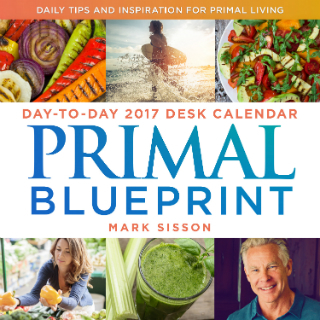 My staff and I are having a great time putting the final touches on one of our most unique and interesting publications yet: a Primal Blueprint Day-to-Day calendar with daily tips and inspiration on primal living. Yep, it’s in the familiar five-inch square pad format on a plastic base (lays down or stands up) made famous by Garfield, the Simpsons, and assorted other light-hearted fodder that fills the bookstore tables during the brief holiday desktop calendar season. So if you’re a little tired of cartoon strip fare and want a resource to keep you focused, inspired and enlightened to new primal information in easily digestible daily tidbits, I think you will love this calendar.
My staff and I are having a great time putting the final touches on one of our most unique and interesting publications yet: a Primal Blueprint Day-to-Day calendar with daily tips and inspiration on primal living. Yep, it’s in the familiar five-inch square pad format on a plastic base (lays down or stands up) made famous by Garfield, the Simpsons, and assorted other light-hearted fodder that fills the bookstore tables during the brief holiday desktop calendar season. So if you’re a little tired of cartoon strip fare and want a resource to keep you focused, inspired and enlightened to new primal information in easily digestible daily tidbits, I think you will love this calendar.
The months are themed in alignment with the 10 Primal Blueprint laws and the Primal Connection’s 10 Habits of Highly Successful Hunter-Gatherers. Many of the days are jam-packed with crisp messages about vitamin D health, the Primal Essential Movements, the psychological benefits of play, the hormonal aspects of fat adaptation, the physical and psychological benefits of spending time in nature or limiting use of digital technology, and so forth. These educational offerings are interspersed with inspirational quotes, recipes, and quick de-stressing tips—all honoring the monthly themes to get you into a good reading rhythm and diverse and fresh experience every time you peel back a new page. You can peel off your favorite workout or recipe tips and stick ‘em on the fridge!
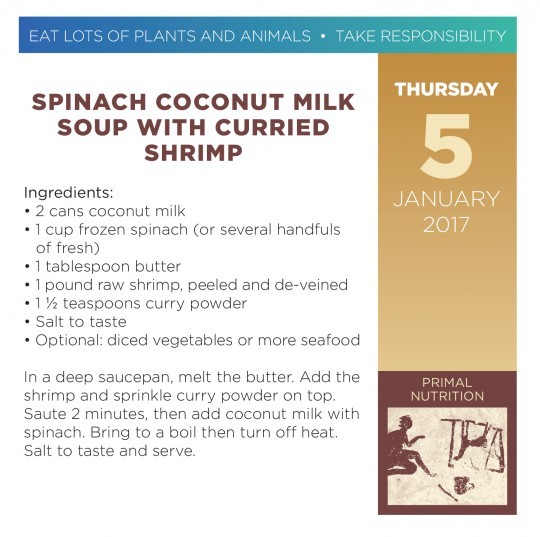

Here’s the thing: unlike books, annual calendars sell only during that narrow time window preceding the New Year and then soon become of little interest. Furthermore, the unique print specs require a much longer lead-time from overseas than our USA-printed books. Bottom line: We are doing one production run, very soon, and when they sell out they are gone. Our distributor expects a strong response in the chain and big box stores upon late-fall release, so I’m offering this special opportunity to MDA readers to get first in line and guarantee you receive your calendar fresh off the press (September, 2016). This is a great holiday gift idea for all your primal friends so consider a quantity order and knock out a good chunk of your holiday gift list with a few clicks.
I know it’s a long way from 2017, so we’ve created a special offer to get you to commit now. Just add the coupon code PBCALENDAR17 at checkout to get the offer below.*
Order a calendar now and get free shipping and a free copy of The Primal Blueprint 90-Day Journal when your calendar ships in September. That’s a $22.95 retail item for FREE! But if you want the journal, you’ll have to act fast, since this pre-order offer expires next week on April 15th. (Note: Limited to one free copy of the 90-Day Journal per customer, per order, regardless of the number of calendars purchased.)

After April 15th, you won’t get the journal. But you can still pre-order a calendar on PrimalBlueprint.com, and you will be prioritized by date of order. However, there’s still a big chance we will sell out. So if you’re interested, I’d recommend pulling the trigger now!
If you plan on giving away a few of these calendars as gifts, you can also take advantage of our 10% quantity discount at checkout.
To reserve your copy of the Primal Blueprint 2017 Day-to-Day Calendar, click here and use coupon code PBCALENDAR17 at checkout.*
*Note: When placing your order for the calendar, do not add items other than the calendar to your cart. Since this is a pre-sale item, your order will only be processed come September. And you wouldn’t want your additional items delayed until then, too!
That’s it, folks! I hope a bunch of you take advantage of the pre-sale offer and enjoy your calendar once you get it. If you have any fun ideas for future calendars, leave a comment below.
Like This Blog Post? Subscribe to the Mark's Daily Apple Newsletter and Get 10 eBooks and More Delivered to Your Inbox for FREE



April 6, 2016
15 Reasons Not to Trust That Latest Nutritional Study
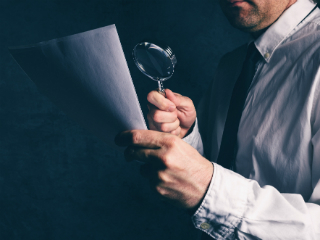 Nutritional studies are often the best we’ve got. Without them, we’d be plucking anecdotes from a swirling vortex of hearsay, old wives’ tales, and prejudices. Some actionable information would definitely emerge, but we wouldn’t have the broader vision and clarity of thinking offered by the scientific method. Most of them are deeply flawed, though. And to know which ones are worth incorporating into your vision of reality and which only obfuscate and further muddy the waters, you have to know what to watch out for.
Nutritional studies are often the best we’ve got. Without them, we’d be plucking anecdotes from a swirling vortex of hearsay, old wives’ tales, and prejudices. Some actionable information would definitely emerge, but we wouldn’t have the broader vision and clarity of thinking offered by the scientific method. Most of them are deeply flawed, though. And to know which ones are worth incorporating into your vision of reality and which only obfuscate and further muddy the waters, you have to know what to watch out for.
Today, I’m going to discuss many of the reasons you shouldn’t trust the latest nutritional study without looking past the headlines.
1. Industry distorts the research.
Last year, Marion Nestle looked at 152 industry-funded nutrition studies. Out of 152, 140 had favorable results for the company who funded it. An earlier analysis of milk, soda, and fruit juice nutrition studies found that those sponsored by milk, soda, and juice companies were far more likely to report favorable results than independent studies. The same things happens in cardiovascular disease trials and orthopedics trials.
2. Ego distorts the research.
People become wedded to their theories. Imagine spending 30 years conducting research to support your idea that saturated fat causes heart disease. How hard will you hold on to that hypothesis? How devastating would opposing evidence be to your sense of self-worth? Your research is your identity. It’s what you do. It’s how you respond when chit chatting at cocktail parties. You’re the “saturated fat” guy. Everything’s riding on it being true.
Scientists are used to being the smartest person in their respective rooms. It’s not easy to relinquish that or admit mistakes. Heck, that goes for everyone in the world. Scientists are not immune.
3. Correlation masquerading as causation.
In day-to-day life, correlative events imply causation. You cut someone off, they honk at you. A man holds a door open, you thank him. You flip a light switch, the light turns on. We’re used to causation explaining correlations. So when two variables are presented together in a nutritional study, especially when it seems plausible (meat causes colon cancer) or reaffirms popular advice (saturated fat causes heart disease), we’re likely to assume the relationship is causal. Correlations provoke interesting hypotheses and tests of those hypotheses, but they’re very often spurious. Everything we eat is associated with cancer if we look hard enough. Does that actually tell us anything useful?
4. No control group.
If you want to know the effects of an experimental intervention, you need a group of people that don’t receive the intervention. That’s the control group. Without a control group to compare against the group that received the experimental intervention, a clinical trial doesn’t mean much. You can’t truly know that the experimental variable caused the change without it.
5. Fake controls.
The presence of a control group doesn’t make it a good study. The control group has to be a real control. Take this paper from last year claiming that oatmeal for breakfast promotes satiety. Sure, when you’re comparing oatmeal to a cornflake breakfast. It doesn’t take much to beat the satiating (non)effects of cornflakes. How would oatmeal compare to bacon and eggs, or a big ass salad, or sweet potato hash? This study doesn’t tell you that.
6. Small sample size.
The smaller the sample size, the less impressive the results. The larger the sample size, the more meaningful the results and the more likely they are to apply to the larger population. That’s why the results of n=1 self-experiments are mostly useful for the person running the experiment on themselves and less useful for others; the sample size of one isn’t enough to generalize the results.
Small sample size studies shouldn’t be ignored. They can lead to interesting questions and hypotheses that larger studies can tackle. But they shouldn’t sway public policy, scientific consensus, or your decision about what to eat and how to live.
7. Demographics.
Make sure you know who participated in the study. If you’re a Latino male of 20 years, the study on low-carb diets in post-menopausal black women may not apply to you.
8. Food frequency questionnaires (FFQ).
FFQs require people to recall their typical diet over the last year. That’s hard. Here’s a sample FFQ (PDF); see how you do trying to recall the foods you ate over the last 12 months. Suffice it to say, they aren’t very reliable. People lie. People forget. People tell you what they think you want to hear, downplaying the unhealthy stuff and overstating the healthy stuff. FFQs are probably the best option available for assessing, but they aren’t good enough.
9. The adherer effect.
Michael Eades calls it the “adherer effect.” I’ve called it the “healthy user effect.” Whatever phrase you prefer, this describes the fact that there’s “something intrinsic to people who religiously take their medicine that makes them live longer,” even if that medicine is a completely inert placebo. Perhaps they’re also more likely to heed other medical advice, like exercising regularly, getting checkups, eating healthy foods, and other behaviors that improve health which could explain some of the beneficial effects. But it’s a real thing, and it has a real effect on the results of nutritional studies.
10. Statistical significance versus clinical significance.
You see the phrase “significantly associated with” a lot in scientific papers. “Fat is significantly associated with type 2 diabetes” sounds like “dietary fat has a large effect on your risk of type 2 diabetes.” But what that phrase really means is “The association between fat and type 2 diabetes is unlikely to be a coincidence.” It says nothing about the size of the association. It doesn’t mean eating fat doubles your chance of getting type 2 diabetes. The clinical significance—the biological effect—is very likely trivial.
11. Relative risk versus absolute risk.
Papers will often talk about “the risk” of something. More often than not, that’s a relative risk. Take something like colon cancer. Though it’s the third most common cancer (and cause of cancer-related deaths), the absolute risk of developing colorectal cancer, even in old age when the risk is at its highest, isn’t exactly high. For the average 50 year old, his or her lifetime absolute risk of colorectal cancer is 1.8%. If that 50 year old has a relative with colon cancer, the absolute risk is 3.4%. Having two relatives with a history of colon cancer pushes it up to 6.9%. On the big scale of things that can kill you, colorectal cancer isn’t even in the top five.
So anything that increases the risk of colon cancer starts from that otherwise meager degree of absolute risk.
12. Nutrients versus foods.
Most nutrition studies attempt to measure the effect of specific nutrients on health outcomes. But people don’t eat palmitic acid. They eat dairy and meat. People don’t eat linoleic acid. They eat almonds, or soybean oil, or pumpkin seeds. People don’t eat glucose, fructose, resistant starch, and prebiotic fiber; they don’t even eat “carbs.” They eat cold potatoes, sweet potatoes, blueberries, wild rice. Studies that look at specific nutrients can’t tell you accurate information about the effects of foods, because foods contain far more than just single nutrients.
13. Most research is wrong.
In 2005, John Ioannidis published a paper called “Why most published research findings are false,” citing conflicts of interest, small sample sizes, insignificant clinical effects, and failures to replicate—in other words, most of the stuff mentioned in today’s post. It eventually became the most widely cited paper ever published in PLoS Medicine, and it’s still true today. Keep it in mind.
14. Journals prefer to publish and researchers prefer to submit exciting studies with strong results.
You’re more likely to have your paper published if it presents a new, exciting finding with a strong result. If two researchers run similar studies and only one gets a positive result, a journal will usually publish the “successful” study and ignore the other one. For their part, researchers are more likely to submit “successful” papers to journals. The end result is a lack of negative results, even though they’re informative and vital for accurate science to prevail.
15. We know very little.
“Blueberries improve memory.” In who? People with dementia, people who are at high risk for it? Can kids improve school performance by eating blueberries? What about college students? What if the college students are female—does that change anything?
“Nuts reduce mortality risk by 40%.” How long do you have to eat the nuts? Does the type of nut matter? Does your age affect the protective effects of nuts?
There’s too much we don’t know. There are too many variables we can’t control.
This isn’t to suggest that nutritional studies are useless. I cite and refer to them all the time. They’re often the best, most objective angle on the situation available. Like democracy, it’s the worst except for all the others. But we have to recognize and consider their limitations. Hopefully after today’s post, you’ll know what to look for.
That’s it for today, folks. Let’s hear from you. What do you think? How do you analyze a nutritional study? What do you look out for?
Prefer listening to reading? Get an audio recording of this blog post, and subscribe to the Primal Blueprint Podcast on iTunes for instant access to all past, present and future episodes here.
Like This Blog Post? Subscribe to the Mark's Daily Apple Newsletter and Get 10 eBooks and More Delivered to Your Inbox for FREE



April 5, 2016
How to Get Organized and Stay Focused in a Modern World
 Getting organized used to be a whole lot easier.
Getting organized used to be a whole lot easier.
As nomadic hunter-gatherers, we only had to keep track of the things we could carry because that was all we owned. As members of a tribe of extended family members, we could lean upon others for assistance with day-to-day tasks and trust they had equal skin in the game. We didn’t have to shoulder everything ourselves, and the responsibilities necessary for survival were simpler. The accessible world was much smaller, the breadth of available knowledge limited by location. You knew all about the lives and goings-on of your immediate community members and which plants were edible in a 20-mile radius and where to get water and when the antelope grazed and the leopard prowled. But what happened 50 miles away was a total mystery, and a thousand miles away might well have been infinitely vast. Important info was recorded through oral traditions—stories and songs. Anecdote and analogy and parable carry weight to this day because for millennia, they were all we had to go on.
Then agriculture happened, followed by urbanization and markets and trade routes and, suddenly, we had a lot more information to process. So we created a system for organizing and externalizing information: writing. Physical writing soon gave way to telecommunication traveling along physical wires and, later, invisible data streams shooting and bouncing across the atmosphere.
Today, we are roving islands of responsibilities, duties, obligations, tasks, schedules, and information hyperconsumers. We have more “freedom” and everything’s amazing and there’s an app for that and that and that. But that just means we have more things to squeeze in and organize our lives around. It used to be if you wanted to go to Hawaii, you told a travel agent and they booked the plane, the hotel, and the rental car. Now we have the freedom to hunt for the best deal ourselves and travel-hack our way into credit rewards for extra miles and scour AirBNB for an amazing pad on the beach. There are benefits, clearly. We have more opportunities and more options, but we’re busier than ever before with fewer people to help shoulder the load. And unless you turn off notifications, your phone’s always alerting you to the existence of something else to cram into your brain.
That’s the rub: on top of the physical world we’ve laid an entirely novel world of digital information that demands even more of our attention. All those tweets, status updates, texts, emails, and snapchats need to be organized alongside our houses, spouses, closets, jobs, bills, cars, and yards. How can our pre-industrial brains stay organized and focus on the things that matter? Here are a few tips to help.
Don’t multitask
You’re answering emails. You’re checking your phone. You’re pinging colleagues. You’re working an Excel spreadsheet. You’re reading MDA. You’re bouncing around from website to app to Twitter feed to phone call to text message. You’re on top the world and optimizing your performance. After all, doing three tasks at once instead of one must be more efficient. Right? Or maybe not, since the evidence clearly shows that multitasking doesn’t work very well.
A 2009 study out of Stanford found that heavy multitaskers—people who reported being frequent multitaskers and felt they were more efficient because of it—were worse at multitasking than people who reported being light multitaskers. When the multitaskers actually tried to multitask, they had trouble switching from task to task, were more easily distracted, and had trouble organizing their thoughts. In a more recent study, performance on a single task was 83%, while trying to do two tasks at once dropped performance to 17%. Multitasking is a lie. Unless the tasks are completely automatic, like breathing and walking, performance of the primary task suffers.
If you insist on multitasking, try passive multitasking, like starting a pot of bone broth or a pot roast in the slow cooker before work. Dinner will be cooking as you work without you having to do any extra work. I also find that integrating exercise into the workday improves my ability to focus and create without disrupting my work flow. This could mean using a treadmill desk, keeping a kettlebell at your desk for occasional sets of swings, or taking pushup/squat breaks every 3o minutes. At home, I usually hop on the slack line for a few minutes when my writing hits a lull.
Take stock of your digital sensory organs
Phones, apps, and social media are sensory organs for our extended digital brains. They provide streams of data and information, and this information either helps or hinders us. Unfortunately, our brain can’t really distinguish between useful and useless information before we see it; it all gets processed simply by virtue of our viewing it, taking up valuable brain resources in the process.
On a free day, take the time to sit down and analyze the data streams in your life. Go through your Twitter feed and survey your “followed” list. Are the accounts you follow making you happy, improving your life, inspiring you, or making you money? Stop following the ones who you answer “no” to. Now do the same for the apps on your phone. If they aren’t improving your existence or are sucking your time away without anything to show for it, delete them. Do this for every digital outlet you maintain.
Avoid anger porn
Between liberals rage-watching Fox News, conservatives gnashing teeth over Obama dancing tango in Cuba, and anyone with a pulse reading Youtube comment sections, people are drawn to opinions and news that enrage them. I call this anger porn, and I’m not sure why we insist on consuming it. At least with regular porn, there’s a pay-off. With anger porn, we just get angry and frustrated. We can’t affect the world events being reported on. We can’t change that other guy’s disgusting opinion (nor can he change your horrendous one); we can reply to comments, but that just turns into a flame war without victors.
Anger consumes you. It depletes you. It’s a huge waste of time and attention.
Take notes
Our memories are fluid—more written in sand than etched in stone. Even our recollections of significant events morph over time until we’re not even sure we’re remembering them correctly. And sometimes they just disappear. How many times have you had a great idea, think “I should write this down,” don’t, and forget all about it? You’d never know because you’ve forgotten all about it!
Keep a notepad handy or download an app like Evernote for your phone. I don’t use Evernote myself, instead preferring to jot stuff down on paper or in my phone’s default notepad, but I’ve got friends and colleagues who swear by it.
Remove temptations
Humans are voracious data hounds. We just love information snacks, little bits of news and gossip that flit across our brains and prevent us from doing what we know we should be doing. And willpower is cool and all, and it’s easy to tell someone “just don’t visit that website,” but in reality? You’re gonna slip up and give in. Don’t rely on willpower. Use one or some of the dozens of tools and apps that block distractions. I’m a big fan of Self Control, which lets you choose which websites to “blacklist,” and for how long. Once a site is blacklisted, you won’t be able to access it for up to 24 hours. Delete it, restart the computer, it’s all in vain. Any and all attempts to bypass the blacklist will fail. For PC and smartphones, Freedom is a similar app.
Say “HELL YEAH” or “no”
Time and attention are finite. We only have so much, and it’s all we have in this life. After that, it’s gone. If we reject this fundamental truth and attempt to take on more tasks than we can complete, we’ll have no time for any of the stuff we care about and our lives will descend into stressed-out ruin. Derek Sivers has an ingenious way of deciding how to allocate his time and energy. If a potential opportunity doesn’t excite him, he doesn’t take it. If it “sounds kinda cool,” that’s not good enough. He’ll only agree to things if they make him say “hell yeah!”
Let your mind wander
Mind wandering is our natural state: where we aren’t engaged and focused on a task, we daydream. And it’s not frivolous. It’s essential. This is when our brain recharges and we stumble upon new avenues of thought. Next time you’re in line at the DMV or strolling along the beach at sunset, resist the urge to pull out your phone and occupy your mind. Let it wander. You need the break.
Don’t respect arbitrary commitments and rules
We all have to pay taxes and die someday. Beyond that, rules descend into varying degrees of arbitrariness. Self-imposed rules are the most arbitrary, like finishing every book you start. What if the book is terrible?
If the book doesn’t grab you in the first 40 pages, stop reading it. This isn’t school. You don’t have to suffer through boring (im)material.
If you “want” to meditate every morning for 20 minutes but can’t seem to do it, stop beating yourself up. You don’t want to meditate, actually, or else you would. That’s okay. There are alternatives. Worrying about not meditating is worse than not meditating.
Avoid decision fatigue
I’ve written on decision fatigue before. It’s a pernicious first-world problem that can sap us of willpower and resolve to do the tasks that matter. Read the post and consider what it says.
Consciously focus
I don’t care what the task is. Entertainment, writing copy, doing spreadsheets, TPS reports, welding, dog walking. Just focus. You could be watching the Walking Dead; actually watch it. Don’t have your phone out. Give yourself fully to the task at hand.
Tidy up
You’ve heard about the rich and measurable benefits of reducing wanton consumption and getting rid of unwanted, unused items cluttering your home. There’s less to worry about, it’s easier to keep clean, you’re more mobile when you don’t have lug hundreds of heavy boxes around, and you spend less money. And as far as organization goes, tidying offers obvious benefits; you actually know where things are kept! But there’s even evidence that your physical space mirrors your mental space and makes it easier to organize your thoughts and complete tasks. Research shows that trying to complete a task in a messy environment is harder than completing it in a clean, neat one. Physical clutter literally inhibits the brain’s ability to focus, process information, and avoid distractions.
Rank your to-do list
Get all your to-do lists out. First, throw out the items that aren’t really important. If they ever become important, they’ll resurface later.
Next, separate them into two groups: big jobs and easy jobs. A big job is something that takes planning, time, devotion, and probably money. An easy job is something you can crank out in an afternoon.
Then, rank each item in each group in order of importance.
Finally, start cranking them out. Go down the line of easy jobs and do them as quickly as you can. Go down the list of big jobs and take the first step to actually start. Never have more than two (one from each list) going at once.
There are of course times where you might have multiple things going on. That’s fine. Using the to-do rankings helps you focus, though. It’s a good rubric for getting things done, far superior to a big floating list of things you kinda have to do, sometime, somewhere.
Realize that “bits” count, too
Allowing large items and responsibilities to pile up is an obvious impediment to organization. Remodeling that bathroom, painting that kitchen, applying to that job, and deciding what you’re going to do about school for your toddler weigh heavily. We acknowledge as such. Everyone does. But what about digital “bits,” like unanswered emails and articles you’ve bookmarked to read later but never do? Because they’re digital, we tend to discount their effect on our focus, but they occupy real space in our lives.
Because our brains are set up to deal with physical things, and the impact of the digital realm isn’t obvious, a big part of getting organized and focused in the modern world is recognizing and acknowledging the obstacles. Now, it may take months or years for this to become second nature. It may be a constant battle. And perhaps several generations down the line, when human biology interfaces directly with tech, we’ll have adapted. Not yet, though.
Thanks for reading, everyone. Take care, and I’d love to hear how you stay organized and focused amidst all the distractions and temptations. What tips would you add?
Like This Blog Post? Subscribe to the Mark's Daily Apple Newsletter and Get 10 eBooks and More Delivered to Your Inbox for FREE






April 4, 2016
Dear Mark: Do I Need to Eat More, Testosterone Levels, HRV and Carbs
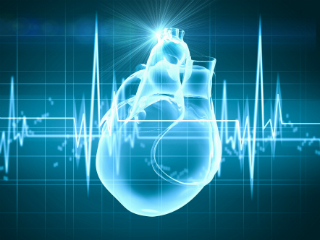 For today’s edition of Dear Mark, I’m answering three reader questions. First, if things are going well on a relatively low-calorie intake, should you just keep on keepin’ on or should you increase food intake to “get ahead” of your needs? Next, what’s the deal with a study showing a high-carb diet is better for testosterone levels than a high-protein one? What does this mean for your Primal way of eating? And finally, can an improvement in heart rate variability after a carb refeed indicate a greater need for carbs?
For today’s edition of Dear Mark, I’m answering three reader questions. First, if things are going well on a relatively low-calorie intake, should you just keep on keepin’ on or should you increase food intake to “get ahead” of your needs? Next, what’s the deal with a study showing a high-carb diet is better for testosterone levels than a high-protein one? What does this mean for your Primal way of eating? And finally, can an improvement in heart rate variability after a carb refeed indicate a greater need for carbs?
Let’s go:
Hi Mark!
First of all, thank you the primal blueprint, I have never slept better, felt healthier and happier than this in as long as I can remember!
I started the Primal Blue print around 5 weeks ago, at the same time I have started to train MMA 4 days a week as well as three days of strength training a week.
What I have found incredible is that even with this new workload on my body, I am only feeling hungry around mid morning at which point I will have some eggs, bacon and vegetables, then I wont eat anything until I arrive home around 8 in the evening for a meal following a full days work along with strength and MMA training!
I started the blueprint weighing 243lbs with around 23% bodyfat, 5 weeks in I weigh 227 lbs, I am stronger, fitter and leaner even though I am not consuming my recommended calorie intake, not nearly as much protein as 0.7G per lb of lean body mass..
Should I consume more protein and fat regardless of my hunger level due to my training, or continue and see where the road takes me?
your advice is greatly appreciated
Many thanks,
David
Pretty cool how it works, huh?
I used to operate with the opposite mindset: how much food can I get away with eating? My old college buddies still call me Arnold (after the pig from Green Acres) because I ate so much, more than even the football players. I was a naturally skinny 19 year-old with an incinerator for a metabolism who ran long distances daily, and I prided myself on being able to eat as much food as I could without gaining an ounce. It was about eating, cause I’ve always loved eating, but it was also a type of ego-stroking. How much food could Arnold eat without gaining body fat? There was almost no limit, seemingly, and I prided myself on that.
These days, I’m convinced the key to health, longevity, and overall performance is to eat as little as you can get away with without sacrificing your health, performance, or energy. Eat as little food while getting the nutrients you need, without taking a hit to your performance or inhibiting your ability to enjoy life. Focus on nutrient density.
Eating Primal tends to celebrate those nutrient-dense, calorie-sparse foods. Meats (including organs), fish, eggs, leafy greens and other non-starchy vegetables (basically free vitamins and minerals). If a food is calorie-dense, like starch, make sure it’s also nutrient-dense. So, favor purple sweet potatoes or regular white potatoes over white rice. It’s also why the use of high-quality fats is so important; grass-fed butter, extra virgin olive oil, avocado oil, and red palm oil contain nutrients to offset the caloric density.
Keep a close watch on your energy levels, body fat, and performance, though. 4 days of MMA and 3 of strength training is a lot of activity, so you may find yourself needing more food. It’s okay if you really need it. Don’t become wedded to your current eating regimen, because your response to it may change. This happens to a lot of people early on in Primal, because you’ve experienced the revelation of burning one’s own body fat for steady, clean energy. Once you get acclimated, you may need to increase calorie intake. Just be open to it is all I’m saying.
Dear Mark,
I’m trying to determine what, if any, effect(s) a lower carb approach has on Testosterone production as well as levels of Sex Hormone Binding Globulin. This study, which held total calories and fat calories constant, suggests that the higher carb diet was better at producing higher T and lowering SHBG:
http://www.ncbi.nlm.nih.gov/pubmed/35...
I’d be interested to get your take. Thank you.
Respectfully,
Rory
Interesting study.
The authors were comparing the effect of either high-carb or high-protein on testosterone, sex hormone-binding globulin, and cortisol. They found that high-carb resulted in higher testosterone, lower cortisol, and higher SHBG. Fat intake was held constant, so only carb and protein intake fluctuated.
I couldn’t get the full paper, so I don’t know how much protein we’re talking here, but if protein was high enough to be the predominant macronutrient in the diet, I’m not surprised.
Protein is a poor energy source. Unlike fat and carbohydrate, it can’t be directly burned or stored as energy and requires conversion into glucose before you can burn it. That conversion is energetically-demanding and metabolically costly, which makes protein great for losing weight and increasing caloric expenditure. And you need adequate protein for a healthy anabolic response. But as the predominant energy source? That’s a stressful diet, and stress is terrible for sex hormone production.
Since we’re not eating high-protein diets as much as high-fat diets, more relevant are the studies that compare high-fat to high-carb diets. On that note, high-fat seems to increase testosterone, while low-fat diets lower it. Saturated and monounsaturated fats seem to be more anabolic than PUFAs.
In an older study, men who customarily ate a 40% fat diet were placed on a 25% fat diet; the lower-fat diet also had a higher PUFA/SFA ratio and more fiber. Their total and free testosterone levels were measured pre- and post-intervention. After going lower-fat and higher-carb, total T dropped from 22.7 to 19.3 and free T from 0.23 to 0.2. Resuming their old diets partially restored their lagging T levels.
Another study in men compared a higher-fat (41%, PUFA/SFA ratio of 0.6) diet to a calorie-matched lower-fat (18.8%, PUFA/SFA ratio of 1.3) diet, finding that serum T was 13% higher on the higher-fat diet.
The ratio of PUFA to SFA also matters. Lower ratios (less PUFA, more SFA) are better for testosterone production.
As far as carbs go, if you’ve “earned” your carbs through heavy training, not eating them can depress testosterone production by creating a stressful metabolic environment.
Dear Mark,
I’ve been measuring my HRV every morning since January in order to better plan my training efforts. My average morning resting HRV is 89. My LF numbers are chronically higher than my HF numbers. I noticed after a heavy carb-binge day (Easter Cake!), though, that my HF numbers had gone up and above the LF numbers, as well as my HRV going to 95. I usually eat very low carb, but am wondering if these numbers are pointing toward me needing a few more in my diet. Obviously not looking to elevate to SAD numbers…But maybe above 80g?
Any advice would be greatly appreciated!
Greg
It couldn’t hurt to try.
This is precisely what I love about measuring heart rate variability: it gives you an objective glimpse at the suitability of your current trajectory. It’s a catch-all. If something isn’t “working,” your HRV will probably reflect it. If something works better, your HRV will probably go up a bit. The trick is to figure out the variable affecting your HRV. In your case, you’re got a good candidate.
Coming off a very l0w-carb intake—anything under 50 grams per day—I’d guess that 80 grams is a nice one to try.
And hey: just keep tracking your HRV until you find your sweet spot. Maybe it’s 80 grams. Maybe it’s 75. Maybe it’s 125. Maybe it’s very low carb for most of the week with a big carb refeed once or twice a week. You don’t know yet, but you will. With HRV monitoring, you don’t have to guess anymore.
That’s it for this week, folks. Thanks for reading!




April 3, 2016
Weekend Link Love – Edition 394
 The Best Paleo Recipes 2015 eBook is 20% off. I contributed a few of my favorites, so go grab a copy.
The Best Paleo Recipes 2015 eBook is 20% off. I contributed a few of my favorites, so go grab a copy.
Research of the Week
Exercising before a stressor dampens its impact.
Not knowing the outcome is worse than the outcome.
Historically vegetarian populations have enhanced long-chain polyunsaturated fatty acid synthesis. In the context of a diet high in the precursor linoleic acid, this genetic variant increases cancer and heart disease.
Does glucosamine work? It depends on the type you take.
Sitting linked to almost 4% of deaths.
Too much downhill running might inhibit hypertrophy. Run up hills, walk down ’em.
Compared to blanching, boiling, and microwaving, both frying and steaming increase antioxidant capacity of foods.
New Primal Blueprint Podcasts

Episode 112: Craig Ballantyne: Host Elle Russ chats with fitness and personal improvement guru Craig Ballantyne about the importance of personal responsibility, avoiding procrastination in the name of research, bowing out of pointless online confrontations, and why everyone needs to have—and share—a vision.
Each week, select Mark’s Daily Apple blog posts are prepared as Primal Blueprint Podcasts. Need to catch up on reading, but don’t have the time? Prefer to listen to articles while on the go? Check out the new blog post podcasts below, and subscribe to the Primal Blueprint Podcast here so you never miss an episode.
8 Primal Rules for Building Better Bones
How a Primal Lifestyle Can Help You Find Your Passion
Should You Sleep-Low to Boost Performance?
Interesting Blog Posts
What’s the evidence for (and against) the paleo diet?
A few things a writer learned from Kelly Starrett.
Media, Schmedia
Pretty much all American “craft” whiskeys are distilled in the same Indiana factory.
Nina Teicholz was bumped from a food science panel. Here’s a petition to reinstate her.
Everything Else
What Robb Wolf’s up to these days.
Bison are going home to Montana, bringing with them a penchant for poutine.
A world map of Neanderthal and Denisovan ancestry.
I bet unicorn tasted awesome.
Mummified frozen puppy corpses still manage to be pretty cute.
Recipe Corner
Quick “roast” your garlic in a pressure cooker.
Have you tried any of these low-carb noodle alternatives?
Time Capsule
One year ago (Apr 6 – Apr 12)
Do You Value Experiences Over Things? – You should try it.
How to Raise Creative and Self-Reliant Free-Range Kids – It’s not just beef that’s better free-range.
Comment of the Week
Your “Big Ass Salad” may benefit greatly from a strategically-placed hyphen.
– I get your drift, His Dudeness, but I prefer to leave it open-ended.




April 2, 2016
Polish Hunter’s Stew (Bigos)
 There are a lot of different recipes out there for Polish Hunter’s Stew (also called Bigos). But in the end, it’s always about two things: meat and cabbage. Hunter’s Stew is a hearty dish made from bacon, kielbasa, a pound or more of meat, plus both fresh cabbage and sauerkraut. If you’re a real hunter, the stew meat in Bigos is whatever you’ve hunted. If your “hunting” is done at the meat counter, then buy what you’re in the mood for or what’s on sale. Venison, pork, beef, lamb…they’re all good in Bigos. This can be a clean-out-your-freezer type of meal.
There are a lot of different recipes out there for Polish Hunter’s Stew (also called Bigos). But in the end, it’s always about two things: meat and cabbage. Hunter’s Stew is a hearty dish made from bacon, kielbasa, a pound or more of meat, plus both fresh cabbage and sauerkraut. If you’re a real hunter, the stew meat in Bigos is whatever you’ve hunted. If your “hunting” is done at the meat counter, then buy what you’re in the mood for or what’s on sale. Venison, pork, beef, lamb…they’re all good in Bigos. This can be a clean-out-your-freezer type of meal.
Cooking the fresh cabbage and sauerkraut long and slow gives the stew its thick, rich texture. However, it also means that the cabbage and sauerkraut won’t deliver a strong one-two punch of probiotics and organosulfur compounds. They’re better at this when eaten raw or lightly cooked. But, man, does Hunter’s Stew taste good, and that’s worth something (plus, keep in mind that Bigos is good with additional fresh sauerkraut on the side.)
As mentioned before, Hunter’s Stew has a lot of variations, so the word “recipe” is used loosely here You can add a little more or less of anything in the ingredient list and the stew will still be delicious. Some versions also add spices like caraway, paprika, allspice and juniper berries. Feel free to add a teaspoon of one, or several, of these seasonings to the pot.
Servings: 6 to 8
Time in the Kitchen: 35 minutes, plus 2 to 4 hours to simmer
Ingredients:
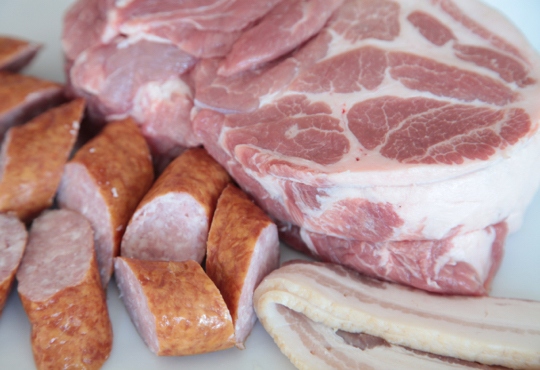
A small handful dried mushrooms (porcini are most common for this recipe)
2 strips bacon, diced
1 ½ pounds (680 g) stew meat (venison, lamb, beef or pork), cut into 1-inch (2.5-cm) pieces, seasoned with salt and pepper
1 onion, chopped
1 cup red wine (240 ml)
1 smoked kielbasa, cut into 1/2-inch pieces (12 ounces/340 g) (13 mm)
1 quart sauerkraut, drained (about 24 ounces/680 g)
½ a head green cabbage, thinly sliced
5 pitted prunes, cut into quarters
1 bay leaf
Instructions:
In a small bowl, cover dried mushrooms with 1 cup boiling water. Set aside, giving the mushrooms time to rehydrate while you prepare the rest of the stew. When the mushrooms are soft, pour the soaking liquid through a fine mesh strainer to catch any grit. Save the strained liquid; finely chop the mushrooms. Set aside.
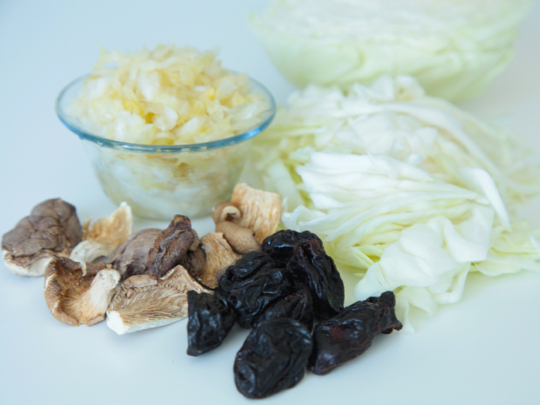
Add the bacon to a large stew pot or Dutch oven over medium heat. When the bacon is crispy, remove it from the pot with a slotted spoon, leaving the fat in the pot. Set the bacon aside.
Add the stew meat in batches–don’t crowd the pot–browning the meat on all sides in the bacon fat. Transfer each batch to a plate when done.
Lower the heat and add the onion, cook 3 to 5 minutes.
Add the wine. Raise the heat to high and bring the wine to a boil while scraping up the browned bits of meat on the bottom of the pot with a spatula or wooden spoon.
Return the stew meat and its juices to the pot, plus the kielbasa, sauerkraut, fresh cabbage, prunes, mushrooms with their liquid, and bay leaf. Mix well, adding a few grinds of salt and pepper and any other spices you want to add.
Cover the pot with a lid slightly ajar. Turn the heat to low and simmer 2 to 3 hours until the stew meat is tender. Or, put the stew in a slow cooker set on low, cooking about 4 hours until the meat is tender. For both methods, stir the stew a few times whiles it cooks.
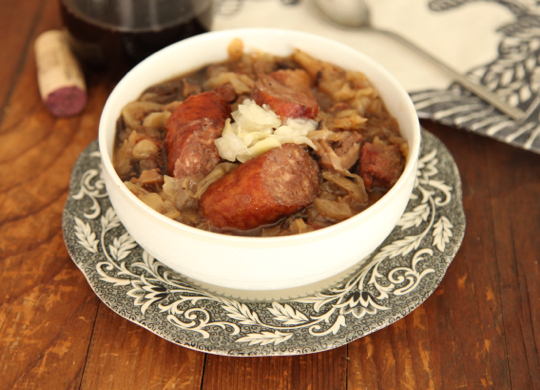




Mark Sisson's Blog
- Mark Sisson's profile
- 199 followers



